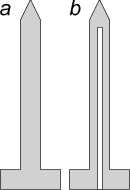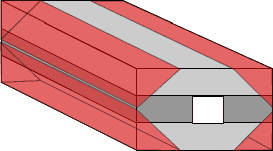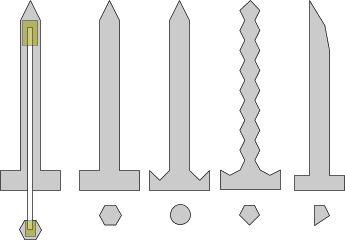In the much-belaboured “Headshots” thread, Telpe mentioned “flats” in reference to a weapon design.
As a larp weaponmaker, I’m interested in learning from other weaponmaker’s experiences. Hence this thread, where we can discuss each other’s designs and techniques.
This is not about My Design Is Better Than Your Design, but more about This is How I’ve Done It.
Skirmish Boffers
The first serious attempt at weaponmaking was the common-or-garden PVC boffer variety. We used closed-cell foam and cloth tape (silver for blades and black for handles) to create shortswords, longswords, javelins (non-thrown, long handles and short blade sections), and polearms. They lasted pretty well, but when we saw Scott Farndon’s and Kath Dewar’s “flat” swords, we were impressed and set about gathering the gear to make some.
Skirmish Fibreglass Core Weapons
We made a dozen or so longswords:
- sail battons as our cores
- closed-cell foam for blades
- corflute for guards
- thin pvc pipes wrapped in bike innertubes for the grip. A 150mm length of sail batton pokes out the bottom of the blade. This is inserted into the pvc pipe and glued using epoxy resin.
- lead tape was used to fashion counter-weighted pommels
- duct-tape was used to finish the sword (no latex); silver for blades, black elsewhere.
Since then we’ve updated our approach to longswords. Corflute is crap for guards - it bends and loosens. Instead we shifted to foam and finally foam-covered PVC pipes. I bought a beltsander and now we can make more blade-like edges to our blades. We have also forged our own pommel-counterweights from roofing lead, these don’t loosen as easily and are cheap to make.
Javelin blades are similar to swordblades, except they are short, wider and have serrated edges. Like swords, javelin blades are inserted into a pvc pipe that will serve as the javelin handle.
We’ve also recycled our old boffer swords by using the swordblade section as the handle. Existing boffer javelins had their blades cut off and replaced as above.
Most of our two-handed weapons follow the same design pattern as the javelin.
I managed to score two 12mm pvc rods that were a good length for a pole arm. I sanded down each end of the rods to make a flat paddle to which I affixed short swordblades. These double-ended polearms are light, rigid and manueverable, and were the signature weapon of Lord Obsidian, my longest lived Mordavian character.
I’ll put up some pics when I have time.
So, how have others made their weapons ?



